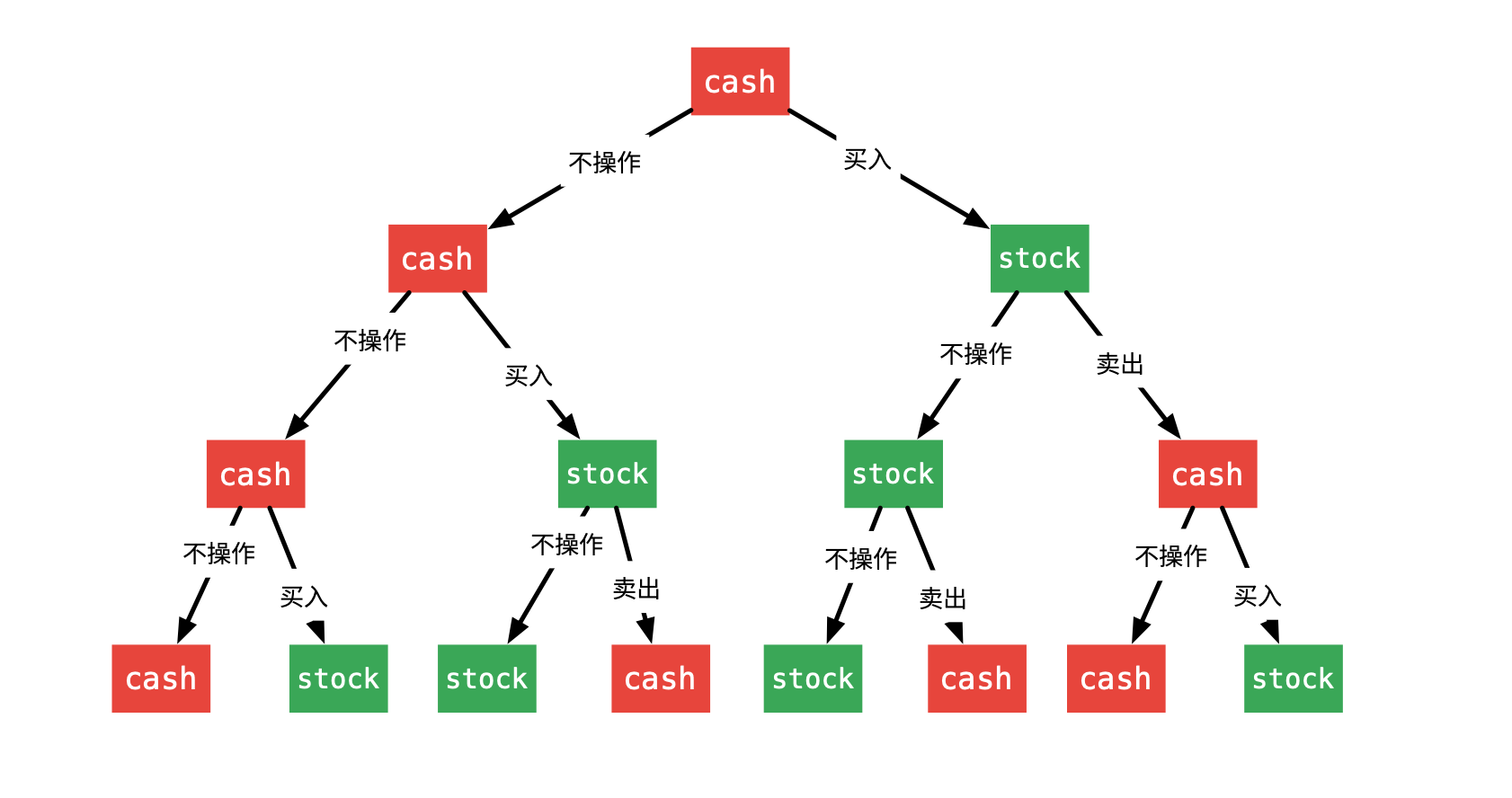基础算法篇-买卖股票的最佳时机2
基础算法篇
LeetCode刷题打卡第2天 2022.12.1
买卖股票的最佳时机2
题目描述
给你一个整数数组prices,其中prices[i]表示某只股票第i天的价格。
每一天,你可以决定是否购买和/或出售股票。你在任何时候 最多 只能持有 一股 股票。你也可以先购买,然后在同一天 出售。
返回你能获得的 最大 利润 。
输入示例
示例1
输入:prices = [7,1,5,3,6,4]
输出:7
解释:在第 2 天(股票价格 = 1)的时候买入,在第 3 天(股票价格 = 5)的时候卖出, 这笔交易所能获得利润 = 5 - 1 = 4 。
随后,在第 4 天(股票价格 = 3)的时候买入,在第 5 天(股票价格 = 6)的时候卖出, 这笔交易所能获得利润 = 6 - 3 = 3 。
总利润为 4 + 3 = 7 。
示例2
输入:prices = [1,2,3,4,5]
输出:4
解释:在第 1 天(股票价格 = 1)的时候买入,在第 5 天 (股票价格 = 5)的时候卖出, 这笔交易所能获得利润 = 5 - 1 = 4 。
总利润为 4 。
数据范围
- 1 <= prices.length <= 3 * 10 4
- 0 <= prices[i] <= 104
解题思路
思路1
使用贪心算法。这也是比较简单且易想到的方法。
这道题与买卖股票的最佳时机1不一样的是,1限制为只有某一天可以买入一次且在后面的某一天才可以卖出一次,而这题每天都可以买入或者卖出,没有次数限制。所以我们只要在每天股票上升前的时候买入,第二天卖出,如果第三天股票再上升,可以在第二天买入,可以理解为上涨的每天都进行买卖,盈利,股票下降或者平就不交易,不亏钱。
算法流程
引入变量temp,表示每天的股票的差价,即temp = prices[i] - prices[i-1];变量result表示结果,总盈利。
过程就是遍历整个数组prices[],记录temp,若为正,则计入总盈利result,否则不给予处理。
Java实现代码
class Solution {
//贪心算法
public int maxProfit(int[] prices) {
int result = 0, temp = 0;
for (int i = 0; i < prices.length - 1; i++){
temp = prices[i+1] - prices[i];
if (temp > 0) {
result += temp;
}
}
return result;
}
}
思路2
来自LeetCode的深搜算法,该算法仅提供思考,由于实际测试数据规模,该算法超时。
将每天交易与否当作树的分叉,可以把整个过程看作一个二叉树,将每条路得到的结果取最大值,就得到我们需要的最终结果。

算法流程
从第day = -1天开始(由于数组是从0号为存储),将后一天day + 1选择买入status = 1,则盈利profit = profit - prices[day + 1],若后一天day + 1选择出售股票 status = 0,则盈利profit = profit + prices[day + 1]。当到达最后一天时day = len - 1,取结果的最大值,并结束当前分支。
Java实现代码
class Solution {
//深度优先搜索
private int result = 0;
public int maxProfit(int[] prices) {
dfs(prices, -1, prices.length, 0, 0);
return this.result;
}
private void dfs(int[] prices, int day, int len, int status, int profit ) {
if (day == len - 1) {
this.result = Math.max(this.result, profit);
return;
}
dfs(prices, day + 1, len, status, profit );
if (status == 0){
dfs(prices, day + 1, len, 1, profit - prices[day + 1]);
} else {
dfs(prices, day + 1, len, 0, profit + prices[day + 1]);
}
}
}
思路3
动态规划思想。
定义 dp[i][0] 表示第 i 天交易完后手里没有股票时获得的最大利润,dp[i][1] 表示第i天交易完后手里还有股票时获得的最大利润。
dp[i][0]的**转移方程 **
第i天交易完之后手里没有股票会有两种情况。第一种情况是 i-1 天交易完之后手里也没有股票,此时第 i 天的最大利润即为前一天手里没有股票的最大利润,即dp[i][0] = dp[i-1][0];第二种情况是 i - 1天交易完成之后手里有股票,第 i 天交易的时候把该股票给卖了,所以当天之后手里还是没有股票的,此时第 i 天获得的最大利润为前一天手里有股票时的最大利润,加上今天这只股票的价格,即dp[i][0] = dp[i-1][1] + prices[i]。
最终取两者之间的最大利润:dp[i][0] = max(dp[i-1][0], dp[i-1][1] + prices[i])。
dp[i][1]的转移方程
这里也会有两种情况。第一种情况是第 i 天没有任何交易,说明手里的股票是 i-1 天就已经购买好的,所以第 i 天的最大利润为 i-1 天手里有股票的最大利润,即dp[i][1] = dp[i-1][1]; 第二种情况是 i-1 天交易完之后手里没有股票,第 i 天的股票是当天新买的,所以第 i 天的最大利润为 i-1 天手里没有股票的最大利润减去第 i 天该股票的价格,即 dp[i][1] = dp[i-1][0] - prices[i];
最终也取两者之间的最大利润: dp[i][1] = max(dp[i-1][1], dp[i-1][0] - prices[i]).
边界条件
-
第一天(
i = 0)不购买当天股票:dp[0][0] = 0 -
第一天(
i = 0)购买当天股票:dp[0][1] = - prices[0]
Java实现代码
class Solution{
//动态规划算法
public int maxProfit(int[] prices) {
if (prices.length < 2) {
return 0;
}
int len = prices.length;
int[][] dp = new int[len][2];
dp[0][0] = 0;
dp[0][1] = - prices[0];
for (int i = 1; i < len; i++ ){
dp[i][0] = Math.max(dp[i-1][0], dp[i-1][1] + prices[i]);
dp[i][1] = Math.max(dp[i-1][1], dp[i-1][0] - prices[i]);
}
return dp[len - 1][0];
}
}



 浙公网安备 33010602011771号
浙公网安备 33010602011771号